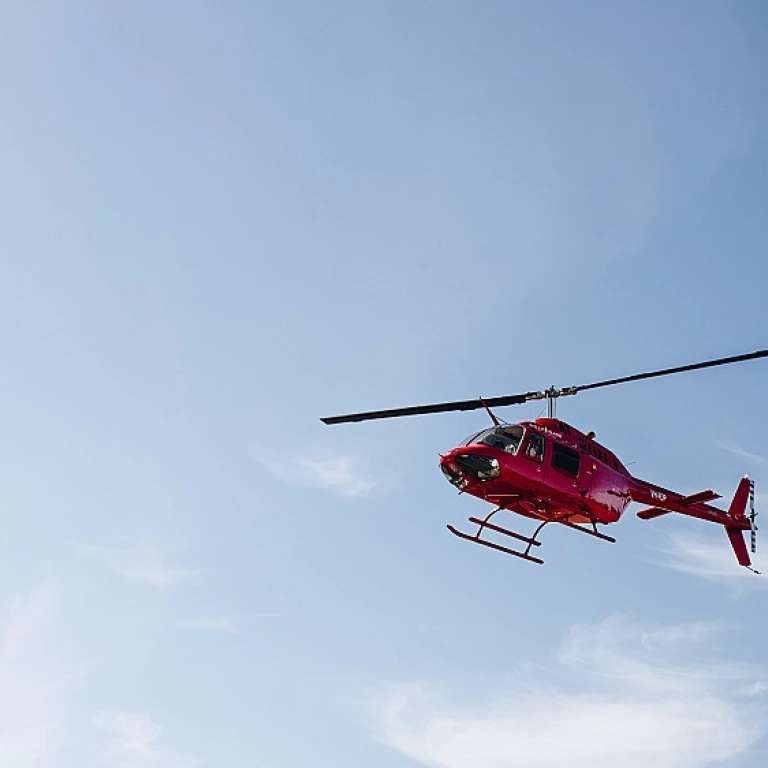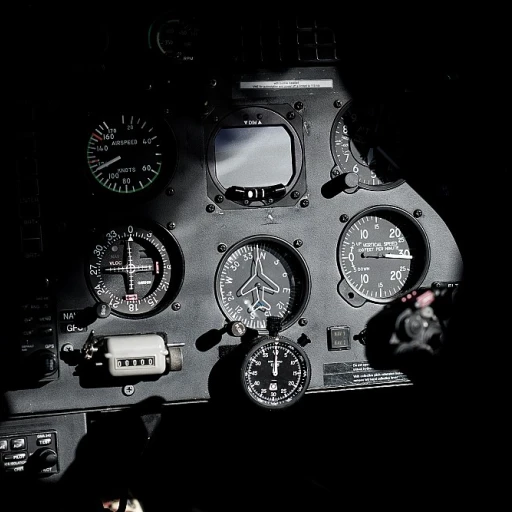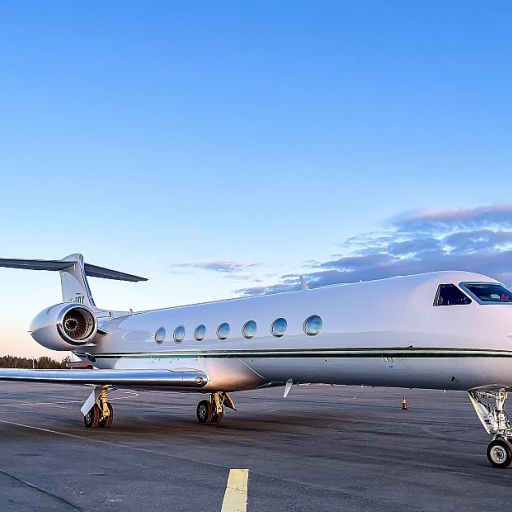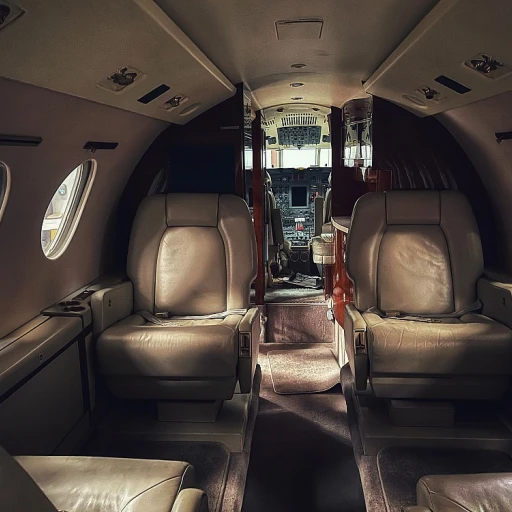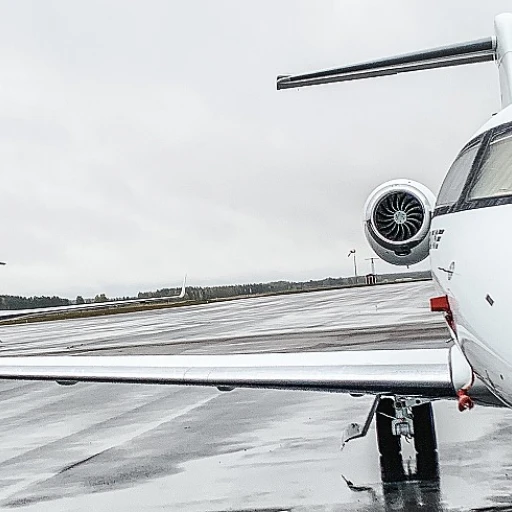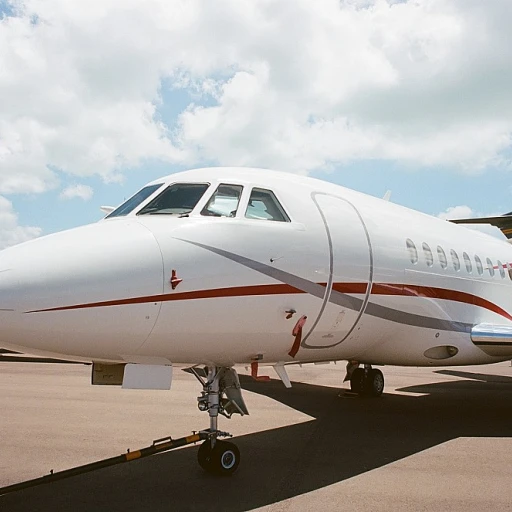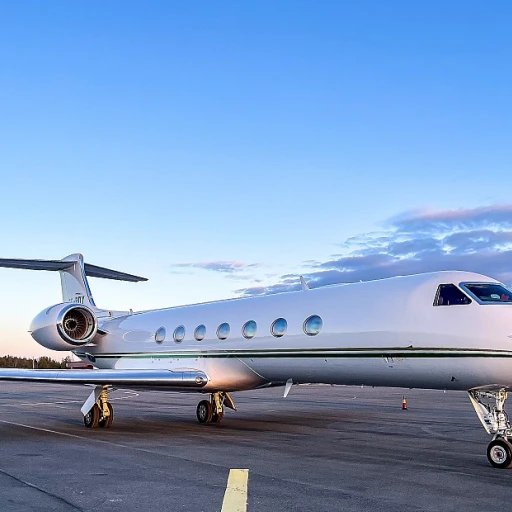
The basics of private jet lease
Understanding private jet leasing
Alright, let's break it down simply. Private jet leasing has become a practical option for businesses and wealthy individuals who need the convenience and flexibility of private aviation without the full commitment of purchasing an aircraft. Essentially, leasing allows you to access a jet for an agreed period without the hefty price tag that comes with ownership.
Choosing a private jet lease over purchase means dodging a significant capital expenditure. You get the luxury of a private jet with fewer financial strings attached. This is an excellent alternative if your flying needs fluctuate or if you're exploring private aviation for the first time.
Here's the scoop:
- Financial Flexibility: Leasing spreads out costs, offering more predictability over financial outlays.
- Maintenance: With most lease agreements, the leasing company handles maintenance, so you're not left fretting over the costs and headaches of upkeep.
- Upgrades: Since you’re not stuck with the same aircraft for decades, you can enjoy the latest models and technology upgrades by renewing or adjusting your lease agreement.
Understanding how lease agreements work
Private jet lease agreements might seem complicated, but they're actually structured to be user-friendly. They typically fall into two categories: wet leases and dry leases.
- Wet Lease: This includes the aircraft, crew, maintenance, and insurance. You're essentially renting a full-service package, which simplifies operations for the lessee.
- Dry Lease: Here, you lease only the aircraft, meaning you must provide your own crew and manage all operational aspects. This might be more cost-effective if you already have aviation resources in place.
Evaluating the cost of private jet leasing
Deciding between leasing and buying a jet hinges significantly on cost analysis. Understanding the cost breakdown of private jet leasing is critical. Generally, leasing rates vary based on the aircraft model, lease length, and whether it’s a wet or dry lease.
As an example, a midsize jet might have an hourly rate ranging from $3,200 to $4,500. This is just a ballpark figure; rates can fluctuate given the specifics of your lease agreement and the market demand.
When leasing a private jet, you’re not simply paying for the flight hours. Operational costs, such as fuel, maintenance, crew salaries, and insurance, also play a crucial role in determining the overall expenditure.
Why people are choosing to lease rather than buy
Leasing a private jet offers flexibility and reduced risk. For businesses, it provides a method to access private jet travel without the long-term commitment. According to Paramount Business Jets, nearly 50% of private jet users are now opting for lease agreements over outright purchases, showcasing a significant shift in the market's preferences.
The commitment-free nature of leasing supports the dynamic travel needs of many modern enterprises and HNWIs (High Net Worth Individuals). Additionally, it mitigates the depreciation risks associated with aircraft ownership.
Exploring the nuances of jet leasing
The idea of leasing is dramatically changing how we perceive private aviation. With evolving business models, you can even opt for smart contracts to manage your lease efficiently. Dive into how smart contracts can revolutionize luxury aviation management.
Cost breakdown of private jet leasing
Breaking down the expenses of leasing your very own jet
So, you're thinking about a private jet lease, huh? Guess what? You're not alone. More folks are ditching commercial flights for private jets. But, let’s be honest – it ain’t cheap. Let’s crunch some numbers and see what makes up the cost.
Initial costs that'll make you go whoa!
First off, expect to pay a significant upfront fee. This can range anywhere from $100,000 to as much as $500,000, depending on the aircraft model. For example, leasing a Gulfstream G650 can set you back a cool $500,000 upfront.
Monthly leasing fees: it all adds up
Then come the monthly fees. These vary wildly based on the model. A light jet like the Citation Ultra might cost around $100,000 per month, while a midsize jet like the Bombardier Learjet 60XR can reach up to $200,000 per month. For something ultra-luxurious like a Boeing Business Jet, you could be looking at $500,000 per month.
Hourly rates: it’s not cheap flying high
Leasing isn't just about a flat fee – you pay per hour too. Light jets can run around $2,000 per hour. Midsize jets? Closer to $4,000. And long-range jets like the Gulfstream G500? You're talking $10,000 per hour. Source: Paramount Business Jets.
Fuel costs: your aviation gas bill
Let’s talk gas money, folks. Expect fuel costs to gobble up a big chunk of your budget. To give you a rough idea, fueling up a King Air might cost about $1,200 per flight hour. Fly a Gulfstream G650, and you're easily looking at $3,500 per hour.
Maintenance and insurance: keeping it airworthy
Okay, now onto maintenance. Private jets need regular upkeep, which doesn't come cheap. Annual maintenance checks for, say, a Learjet might cost around $100,000. Add insurance, and tack on another $80,000 annually.
Crew costs: a team that keeps you flying
Don’t forget about the folks flying the bird. Hiring a pilot can cost around $100,000 annually, plus another $50,000 for a co-pilot. Cabin crew? About $40,000 each per year. And you’ll need ‘em all if you plan to travel regularly.
Additional expenses: not-so-hidden fees
Last but not least, there are incidentals – things like hangar fees, landing fees, and catering. Depending on your itinerary, these can add another $10,000 to $20,000 per month. Source: unlocking financial flexibility.
All in all, what's the damage?
When you add it all up, you could be staring at over a million bucks a year for the pleasure of having your own private jet ready at a moment’s notice. But for many, the convenience, time-saving, and sheer luxury it brings are worth every penny.
Comparing private jet lease with jet ownership
Financial implications and considerations
Comparing a private jet lease with outright jet ownership involves understanding the financial impact of both options. In a lease, you don't need to worry about the significant capital expenditure required for purchasing a jet. According to Paramount Business Jets, leasing costs generally range from $1,200 to $12,000 per hour depending on the type of jet [source: Paramount Business Jets]. On the ownership side, the acquisition cost for a new private jet typically ranges from $3 million to $90 million, plus additional annual ownership costs which can add up to an estimated 10-15% of the purchase price for maintenance, crew salaries, insurance, and storage [source: Flexjet]. These ongoing costs can make ownership quite a financial burden.Flexibility and commitment
Leasing offers greater flexibility compared to owning. With a lease, you can choose from short-term or long-term contracts based on your needs. This allows you to adjust your travel arrangements without being tied down by the long-term commitment and depreciation worries that come with ownership. According to Embraer, light jets like the Phenom 300 are popular choices for mid-range leases due to their operational efficiency and cost-effectiveness [source: Embraer]. In contrast, ownership ties you up with a specific aircraft and the hassles of managing it. Leasing companies such as NetJets and Flexjet offer various leasing packages, allowing clients to switch between different aircraft models as per their travel requirements [source: NetJets, Flexjet]. This level of flexibility is something that outright ownership cannot provide.Tax implications
Tax benefits of leasing a private jet can be attractive. Leasing allows for potential tax deductions on the lease payments made for business use. The Federal Aviation Administration (FAA) provides guidelines on tax benefits for leasing, including deductibles on operational leases. In contrast, jet owners might face higher tax liabilities as the acquisition costs are capitalized and depreciated over several years [source: FAA]. Additionally, leasing may bypass certain state sales taxes that come with the purchase of an aircraft. For instance, some states in the U.S. such as Florida levy an upfront sales tax on the sale of a new private jet, which can be a considerable amount, sometimes running into millions [source: FAA].Maintenance and depreciation
Leasing spares you from the steep depreciation that comes with owning an aircraft. New jets lose 30% to 50% of their value within the first five years. By leasing, you sidestep this financial hit. Moreover, maintenance is often included in the leasing contracts, so you avoid the unexpected costs associated with keeping a private jet airworthy [source: Gulfstream]. In contrast, owners are responsible for regular maintenance and regulatory compliance, which can be both time-consuming and expensive. For long-range jets like the Gulfstream G650, annual maintenance costs alone can reach into the hundreds of thousands [source: Gulfstream]. For more nuanced insights on how smart contracts can revolutionize jet leasing, you might find this article on jet leasing simplified particularly helpful.Popular private jet models for leasing
The most popular light jets for leasing
If you need short-range or interstate travel, check out the Cessna Citation Ultra. It offers a great blend of speed and comfort. With a range of around 1,965 nautical miles, you can comfortably traverse between cities like New York and Miami in about 2.5 hours. The Citation Ultra also accommodates up to 8 passengers, making it a popular choice for business trips.Midsize jets that matter
For a bit more room and extended range, turn to midsize jets. The Bombardier Learjet 60 and Hawker 800XP lead the pack. The Learjet 60 can fly roughly 2,405 nautical miles and takes you from Los Angeles to Chicago non-stop. Meanwhile, the Hawker 800XP offers a quieter cabin and can cover distances up to 2,640 nautical miles, perfect for a cross-country trek.When range and size counts: super midsize jets
Super midsize jets like the Bombardier Challenger 350 and Embraer Legacy 500 combine range, speed, and luxury. The Challenger 350 has a range of 3,200 nautical miles, easily handling trips such as New York to Los Angeles. The Legacy 500 stands out for its spacious interior, offering seating for up to 12 passengers, and can travel 3,125 nautical miles non-stop.Long-range jets for globe-trotting
Gulfstream jets are synonymous with long-range capabilities. The Gulfstream G650 can fly up to 7,000 nautical miles, virtually connecting any two cities globally with just one refueling stop. Another star is the Bombardier Global 6000, offering a range of around 6,000 nautical miles. This model is favored among high-profile clients for its state-of-the-art cabin technology.Ultra-long-range jets for the ultimate comfort
For unparalleled convenience and range, ultra-long-range jets are the pinnacle. The Gulfstream G650ER can stretch out to 7,500 nautical miles, allowing for non-stop travel from New York to Hong Kong. Similarly, the Bombardier Global 7500 offers a remarkable range of 7,700 nautical miles and can fly ultra-long transcontinental routes in luxurious comfort.Notably, Boeing Business Jets (BBJ) and Airbus ACJ aircraft also straddle into this category, transforming commercial airliner platforms into flying palaces with customizable interiors.
Choosing the right model depends on your specific needs, from the number of passengers to the desired range and cabin amenities. Each type has its own unique selling points, so making an informed decision will ensure you pick a jet that's just right for you.
Case studies: successful private jet leases
Examples of thriving private jet leases
Dipping into real-world cases, the success stories surrounding private jet lease arrangements are numerous. Consider the case of Flexjet, which has refined the art of leasing with a tailored program that sees high demand among its wealthy clientele. According to a BusinessWire report, Flexjet reported a 50% revenue growth attributed to their innovative and premium offerings in the fractional jet rental space.
An equally compelling example is NetJets, a pioneer in private aviation, boasting a fleet of over 750 aircraft. Their strategic jet lease options, coupled with FAA compliance and superior customer service, have made them a go-to for business magnates seeking seamless private aviation experiences. As noted in a Forbes article, NetJets witnessed a significant surge in bookings, particularly in the U.S., as clients increasingly sought the flexibility and luxury of leasing over buying.
Leasing experiences with midsize and super midsize jets
Another insight into the practical applications of jet leasing can be found in the stories of clients leasing midsize to super midsize jets. A notable case is the leasing of a Bombardier Challenger 350, favored for its blend of performance and comfort. According to Aviation Week, companies like NetJets have placed orders for this model, citing its versatility and reliability as major draws for clients flying routes like New York to Los Angeles and New York to Miami.
Similarly, the Gulfstream G280 has gained traction in the lease market. As detailed by Gulfstream's official site, the G280 offers a practical solution for those needing a long-range aircraft that can comfortably fly routes such as New York to London.
Most preferred light jets for private leasing
Light jets such as the Embraer Phenom 300 and the Citation Ultra continue to dominate the light jet leasing market. These jets are particularly popular for shorter travel requirements, offering economical solutions without compromising the luxury that private aviation customers expect. Embraer highlights how the Phenom 300, with its efficient operations and comfortable interior, has become a leasing favorite.
Financial insights: Paramount Business Jets' success story
Paramount Business Jets also provides an intriguing case study. Known for their competitive pricing and bespoke services, they offer an array of leasing options that cater to both private individuals and corporate clients. According to their internal reports, leasing inquiries have surged by approximately 30% year-on-year. Their programs, which often emphasize empty leg flights and cost-saving opportunities, underscore how leasing can be a financially savvy alternative to outright ownership, which aligns well with modern business aviation strategies.
In conclusion, these case studies not only demonstrate the versatility and appeal of private jet leasing but also highlight how industry leaders are leveraging leasing programs to meet evolving customer demands. The success of companies like Flexjet, NetJets, and Paramount Business Jets, each with their unique leasing strategies, provides a blueprint for both potential lessees and industry newcomers.
Trends in the private jet leasing market
Predicting the future of the private jet lease market
The private jet lease market is on a constantly changing path, influenced by various factors such as advancements in technology, variations in customer preferences, and economic shifts. Understanding these trends can help potential lessees and industry stakeholders make informed decisions.
According to Fortune, the global private jet market is expected to reach $39.84 billion by 2030, driven by increasing demand for long-range and ultra-long-range jets. Light jets, super midsize, and midsize jets remain popular, but there's growing interest in business jet leasing due to their enhanced range and comfort.
Emerging technology and sustainability trends
Technological advancements are reshaping the private jet leasing sector. Electric and hybrid propulsion systems are emerging, with companies like Honda Aircraft and Embraer at the forefront. In addition, sustainable aviation fuel (SAF) is seeing increased usage. As of 2022, Statista reports that 3% of jet fuel in the U.S. is SAF, a number expected to grow significantly.
Additive manufacturing, or 3D printing, is another promising trend. This technology is enabling more cost-effective production of jet components, reducing both manufacturing time and costs, as highlighted by the Federal Aviation Administration (FAA).
The impact of economic factors
Economic conditions play a crucial role in the private jet lease market. The global pandemic saw a spike in private aviation usage due to health concerns, privacy needs, and the desire for flexible travel. According to Global Newswire, there was a 21% increase in private flight hours in 2021 compared to 2020. This demand is expected to stabilize but remain higher than pre-pandemic levels.
Moreover, geopolitical factors and fluctuating fuel costs influence leasing rates. For instance, the Russian-Ukraine conflict caused aviation fuel prices to surge, which in turn impacted jet rental costs. The U.S. Energy Information Administration (EIA) reported a 50% increase in fuel costs in 2022, affecting leasing terms and hourly rates.
A shifting demographic of private jet users
The demographic profile of private jet users is evolving. Increasingly, younger entrepreneurs and tech-savvy individuals are opting for private jet leases instead of ownership. This demographic values flexibility, preferring short-term leases or on-demand charter flights over long-term commitments.
Research by Paramount Business Jets highlights that millennials and Gen Z travelers are driving changes in the market. These groups prioritize eco-friendly options and digital connectivity, influencing manufacturers and leasing companies to adapt their offerings accordingly.
This trend is echoed by data from NetJets, where a significant portion of their new customers under 40 are opting for fractional ownership as a step between traditional charter and full ownership.
Regional variations in demand
Geographical location affects private jet leasing trends. In the United States, key hubs like Los Angeles, New York, and Fort Lauderdale see high demand for air charter services. Data from the National Business Aviation Association (NBAA) notes that 40% of the global private jet market is centered in North America.
There is also growing interest in emerging markets. Asia and the Middle East are experiencing rapid growth in private jet leasing, driven by expanding high-net-worth individuals and business activities. Airbus and Gulfstream are seeing a rise in demand from these regions due to their long-range and ultra-long-range jets, which are suitable for intercontinental flights.
Regulations and compliance in private jet leasing
Regulatory Landscape and Compliance in Private Jet Leasing
The role of the FAA in private jet leasing
The Federal Aviation Administration (FAA) is the key regulatory body overseeing the private aviation sector in the United States. They ensure that all jets, whether leased or owned, comply with stringent safety regulations. These regulations encompass various aspects, from maintenance protocols to pilot certification. For instance, the FAA mandates that pilots must have at least 1,500 flight hours for an Airline Transport Pilot (ATP) certificate, crucial for operating larger aircraft and ensuring passenger safety (Source: FAA.gov).Aircraft registration and certification
Leasing a private jet involves compliance with both domestic and international regulations regarding aircraft registration and certification. Each leased aircraft must be registered with the appropriate aviation authority. In the U.S., this is managed by the FAA. Additionally, the jet must hold a valid Certificate of Airworthiness, confirming it meets safety and maintenance standards.International aviation regulations
When flying internationally, private jets must adhere to the regulations set by both the International Civil Aviation Organization (ICAO) and the governing body of each destination country. These regulations can include everything from airspace restrictions to noise control policies. For example, the European Union has stringent noise regulations that jets must comply with to land at EU airports (Source: ICAO.int).Tax implications and financial compliance
Understanding the tax implications of leasing a private jet is crucial for making informed decisions. Various tax laws impact private jet leases, including sales tax, use tax, and potentially luxury tax. According to a study by the National Business Aviation Association (NBAA), tax compliance is a significant factor in determining the overall cost of a private jet lease. Companies like Paramount Business Jets often provide consultancy services to help clients navigate these financial waters.Environmental regulations and sustainability
The aviation industry is under increasing pressure to reduce its carbon footprint. Consequently, private jet leases must often comply with environmental regulations aimed at reducing emissions. The FAA and the Environmental Protection Agency (EPA) in the U.S. have implemented guidelines to minimize the environmental impact of private jets. Information from the Global Business Travel Association (GBTA) indicates that more lessees are seeking eco-friendly options, thereby influencing market trends in jet leasing.Expert insights on compliance challenges
"Compliance in the private aviation industry is far from straightforward," says aviation attorney John Schmidt. "Navigating the complex web of regulations requires expertise and vigilance, which is why many firms invest heavily in legal and regulatory support when leasing aircraft." Schmidt highlights the importance of working with experienced aviation management companies who can handle the intricate details, ensuring all protocols are met.Case studies on successful compliance strategies
One notable example is Flexjet, a leading player in the private jet leasing market. They have successfully navigated numerous regulatory challenges by maintaining a dedicated compliance team. Flexjet’s proactive approach includes continuous training for pilots and maintenance crews, regular audits, and close collaboration with aviation authorities. Their adherence to regulations not only ensures flight safety but also boosts client trust and satisfaction. In summary, while leasing a private jet offers numerous benefits, it requires strict adherence to a multitude of regulations. Understanding these compliance aspects is essential for a smooth leasing experience and helps avoid legal complications down the line.Expert tips for negotiating a private jet lease
Know your needs and use the right timing
When negotiating a private jet lease, understanding your needs can significantly influence the terms you agree on. For example, leasing a private jet for frequent business trips versus occasional vacations can affect your hourly rate and lease conditions.
Research market rates and comparable leases
Comparing lease agreements and market rates is important. According to Paramout Business Jets, the hourly rate can range from $1,300 for light jets to $8,000 for long-range jets like the Bombardier Global Express. Knowing these figures allows you to negotiate accurately.
Consider additional expenses
While engaging in negotiations, factor in costs such as fuel, crew fees, and maintenance. For instance, Flexjet offers detailed breakdowns showing how these variables impact the overall cost of private jet leasing. Understanding these costs wards off any unpleasant surprises.
Leverage your relationship with aviation experts
Experts like Paul Schweitzer of Executive Jet Management emphasize that forming good relations with leasing companies can result in better deals. Likewise, working with a qualified broker can ease the negotiation process. Mike Silvestro, CEO of Flexjet, also recommends relying on experienced professionals for hassle-free leasing.
Negotiate lease flexibility
Flexibility is key in leases. Options like empty leg flights can reduce costs substantially. For example, NetJets offers flexible cancellation policies, which benefitted businesses during the pandemic by reducing sudden travel cancellation expenses.
Exploit competitive scenarios
Employing competitive situations can be advantageous. Jet lease offers from multiple providers help in leveraging better rates and conditions. Statistics show that creating competition can lower lease rates by up to 15%.
Understand the fine print
Regulations and compliance, especially those mandated by the FAA, are integral to any lease agreement. Ignoring these can result in costly legal battles. Familiarize yourself with federal aviation administration regulations and other requirements to stay compliant.
Take advantage of promotions and incentives
Lastly, look out for promotions and incentives offered by leasing companies, such as reduced hourly rates or extra flight hours for early sign-ups.
